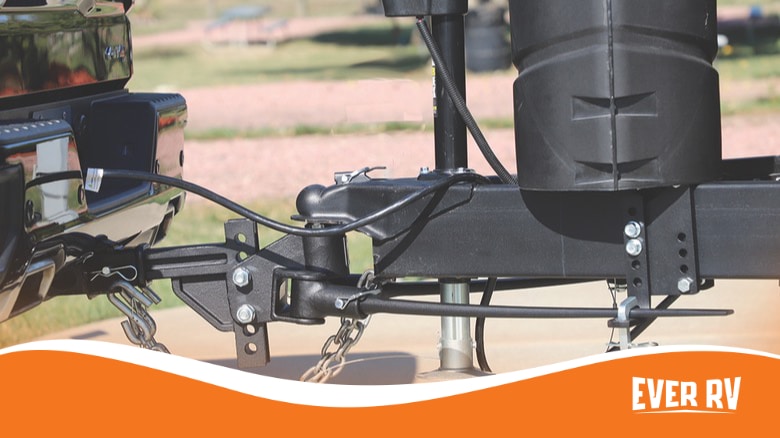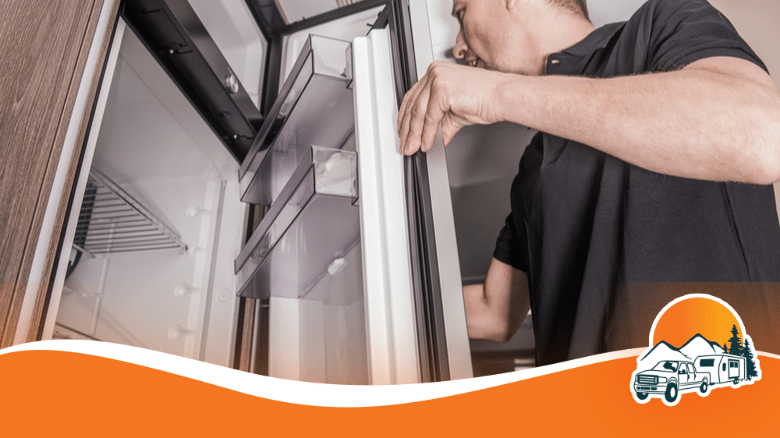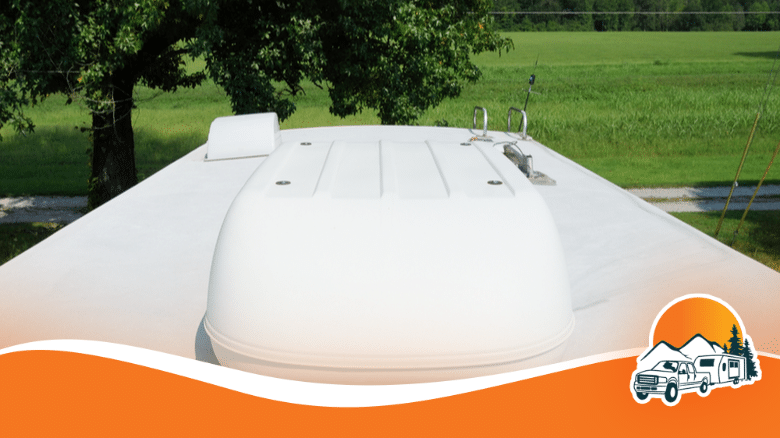Choosing the right size weight distribution hitch for your towing setup is essential for a safe and efficient towing experience.

This decision may seem daunting, but with some basic understanding of the different components involved and your towing vehicle’s specifications, you’ll be able to make the right choice.
A properly sized weight distribution hitch will ensure stability, reduce sway, and improve drivability.
A weight distribution hitch redistributes the weight of the trailer to the front axle of your towing vehicle, balancing the load and distributing the weight more evenly across both vehicles.
This makes driving smoother and safer while reducing stress on your vehicle’s suspension system.
To select the correct size hitch, you’ll need to consider your vehicle’s towing capacity and the tongue weight of your trailer.
Key Takeaways
- A properly sized weight distribution hitch is crucial for safe and efficient towing
- Consider your vehicle’s towing capacity and trailer tongue weight to determine the right size hitch
- Adequate weight distribution improves stability, reduces sway, and lessens stress on the vehicle’s suspension system
Understanding Weight Distribution Hitch
When towing a trailer, it is crucial to maintain the stability and safety between your tow vehicle and trailer.
A weight distribution hitch (WDH) is designed to help distribute the trailer’s weight evenly across your tow vehicle’s axles. This reduces sway, improves handling, and makes the towing experience more comfortable.
A common question when using a WDH is, what size weight distribution hitch do I need? To determine the appropriate size for your towing setup, consider the following factors:
- Gross Trailer Weight (GTW): This is the total weight of your loaded trailer, including cargo and everything else in it. You’ll need a WDH rated to handle this weight.
- Tongue Weight (TW): The downward force exerted by the trailer’s coupler on the hitch ball of your tow vehicle. It’s typically 10-15% of the GTW. Your WDH should be rated for this weight as well.
To select the proper WDH size, follow these steps:
- Determine your trailer’s GTW and TW: Weigh your loaded trailer to obtain its GTW. Measure the tongue weight using a TW scale or calculate it as roughly 10-15% of the GTW.
- Check your tow vehicle’s towing capacity: Review your vehicle’s owner’s manual for the maximum towing capacity and ensure it can handle your trailer’s weight.
- Choose a WDH rated for your GTW and TW: Select a WDH with a TW rating that matches or exceeds your trailer’s tongue weight and a GTW rating suitable for your trailer’s weight.
By following these guidelines and choosing the right size weight distribution hitch, you can ensure the safety and stability of your towing experience.
Key Components of Weight Distribution Hitch
Hitch Head
The hitch head is a critical component of your weight distribution hitch system. It connects to the tow vehicle’s receiver and is responsible for distributing the tongue weight evenly across the tow vehicle and trailer axles.
The hitch head should be properly adjusted to ensure appropriate weight distribution and prevent issues such as trailer sway.
When selecting the right hitch head, consider your specific setup’s Gross Trailer Weight (GTW) and tongue weight.
Spring Bars
Spring bars are the main force distributors in a weight distribution hitch system.
They connect the hitch head to the hookup brackets on the trailer frame and help ensure that the weight is evenly distributed across both the tow vehicle and the trailer.
These bars come in different weight ratings and styles:
- Round bars: Round bars are a common choice that works well with most setups. They are versatile and can be used on trailers with light to medium tongue weight.
- Trunnion bars: Trunnion bars are designed for trailers with heavier tongue weight. They provide greater leverage and control, making them ideal for larger trailers.
Choosing spring bars with the appropriate weight rating to match your trailer’s tongue weight is essential.
Hookup Brackets
Hookup brackets attach the spring bars to your trailer’s frame, ensuring a secure and stable connection. They come in different styles, such as bolt-on and snap-up brackets, each offering specific benefits.
- Bolt-on brackets: These brackets are permanently attached to the trailer frame by bolting them in place, providing a strong and secure connection. This type of bracket is ideal if your trailer’s frame is compatible with bolt-on brackets and you prefer a more robust connection.
- Snap-up brackets: Snap-up brackets offer a more straightforward installation and can be easily adjusted and removed as needed. However, they may not be as strong as bolt-on brackets due to their design.
When selecting your hookup brackets, it’s important to ensure compatibility with your trailer frame and spring bars to create a safe and effective weight distribution hitch system.
Determining the Right Size Weight Distribution Hitch
Before you can select the right size weight distribution hitch for your towing setup, it’s important to understand your tow vehicle’s and trailer’s specifications.
This will involve considerations of their Gross Vehicle Weight Ratings (GVWR), Gross Trailer Weight (GTW), and tongue weight.
The first step is to find the GVWR of your tow vehicle. This information can typically be found on a label in the driver’s door jamb or your vehicle’s owner’s manual.
The GVWR represents the maximum weight your tow vehicle can safely handle, including the weight of the vehicle itself, passengers, cargo, and the tongue weight of the trailer.
Next, determine the GTW of your trailer. This is the combined weight of the trailer and its cargo.
You should not exceed the maximum towing capacity of your tow vehicle, which can also be found in the owner’s manual.
Once you know your tow vehicle’s GVWR and your trailer’s GTW, you’ll need to figure out the tongue weight.
Tongue weight is the downward force exerted on the hitch by the trailer’s tongue, or the part that connects to the tow vehicle.
To ensure an even distribution of weight and a stable towing experience, the tongue weight should typically be between 10% and 15% of the GTW.
With these three numbers in hand, you can now determine the right size weight distribution hitch for your needs.
Weight distribution hitches are typically rated based on their maximum tongue weight and GTW capacities, so you’ll want to choose one that can accommodate your determined values.
To help you maintain a level and stable towing experience, be sure the weight distribution hitch you choose is compatible with your tow vehicle’s hitch receiver and your trailer’s tongue attachment.
This will ensure that not only is the hitch appropriately sized but also that it can be properly mounted in order to function effectively.
By taking the time to understand these key specifications and carefully selecting the right size weight distribution hitch, you can help ensure a safe and enjoyable towing experience with your vehicle and trailer combination.
Installation Process
First, ensure you have the correct size weight distribution hitch for your vehicle and trailer combination. Before beginning the installation, park your towing vehicle and trailer on a flat surface.
Start by inserting the hitch shank into the receiver of your towing vehicle. Secure the shank with a hitch pin and clip.
Next, attach the head assembly to the shank by sliding it onto the shank and lining up the holes. Secure the head assembly with bolts and nuts, torquing them to the manufacturer’s specifications.
Now, it’s time to install the spring bars. Insert each spring bar into the head assembly, ensuring the chains face the trailer.
Attach the lift brackets to your trailer frame, positioning them as instructed by the manufacturer. The brackets should be parallel to the ground.
After the brackets are in place, lift the trailer tongue and attach the chains to the brackets using the provided hooks.
Make sure that the tension in the chains is even on both sides. Adjust the chain links as necessary to achieve the proper tension.
Finally, attach the sway control components if your weight distribution system includes them.
Follow the manufacturer’s instructions for proper attachment and adjustments. Once complete, lower the trailer tongue onto the hitch ball and lock it into place.
You have now successfully installed your weight distribution hitch. Before hitting the road, double-check all connections and ensure everything is properly tightened.
How Weight Distribution Affects Towing
Proper weight distribution is essential for safe and efficient towing when you tow a trailer.
If the weight of the trailer is not evenly distributed across the tow vehicle and trailer axles, it can cause issues like trailer sway, poor handling, and a decrease in the overall weight-carrying capacity.
As you add more weight to the trailer, the center of gravity shifts.
Ideally, you want the center of gravity to be lower and more centralized to minimize any potential swaying and ensure the tow vehicle remains stable.
By using a weight distribution hitch, you can successfully balance the load and improve the overall towing experience.
An improperly balanced trailer can strain the tow vehicle’s suspension, brakes, and tires.
This increased stress decreases your tow vehicle’s control, which can lead to potential accidents or damages.
Proper weight distribution can help mitigate these risks and increase your tow vehicle’s weight-carrying capacity.
A weight distribution hitch evenly distributes the tongue weight of the trailer across the tow vehicle and trailer axles.
This results in a more level ride and improved stability, especially in instances where the trailer’s tongue weight exceeds 10% of the gross trailer weight.
Using a weight distribution hitch can significantly reduce trailer sway and improve your overall control when towing.
In conclusion, understanding the importance of proper weight distribution when towing is crucial to ensuring safety and efficiency.
Using a weight distribution hitch can significantly improve your towing experience by stabilizing the trailer, reducing sway, and increasing weight-carrying capacity.
Products and Solutions
When it comes to selecting the right size weight distribution hitch, you have various products and solutions at your disposal.
Understanding your specific needs and requirements is essential, as well as taking into consideration any recommendations from real experts in the field.
One way to gather this valuable information is by talking to your neighbors and fellow customers who have experience with weight distribution hitches.
They can offer first-hand insights and advice on the products they have used and the solutions they have found most effective.
If you’re unsure where to start, making phone calls or sending emails to professional hitch installation companies can be a great approach.
These experts can guide you on the most suitable weight distribution hitch for your towing needs based on your vehicle’s specifications and the trailer you’ll be towing.
Some popular product offerings in the market include:
- Adjustable Hitches: These hitches offer flexibility in terms of weight capacity and can be adjusted according to your requirements.
- Fixed Hitches: A fixed hitch is pre-set to accommodate a specific weight range. This type of hitch is ideal if you consistently tow the same weight loads.
- Round Bar Hitches: These hitches have round spring bars for weight distribution and are typically more affordable than other options.
- Trunnion Bar Hitches: Featuring a square or rectangular-shaped spring bar, trunnion bar hitches can handle heavier loads and might be a better fit for your needs if you tow large trailers.
To make the most informed decision, take time to research each of these products and weigh the pros and cons.
Additionally, consider any specific features or add-ons, such as sway control mechanisms or built-in brake controllers, that might enhance your towing experience.
Choosing the right size weight distribution hitch significantly affects the safety and stability of your towing experience.
By exploring multiple options and seeking advice from experts, you can find the perfect solution tailored to your needs and give yourself peace of mind on the road.
Conclusion
When selecting a weight distribution hitch, it’s essential to consider the weight of your trailer and towing vehicle.
Ensure that the hitch’s weight capacity matches or exceeds the combined weight of your towing setup. This will provide optimal safety and stability while on the road.
It’s also important to account for your trailer’s tongue weight.
This will help you choose the appropriate hitch system that maintains a balanced distribution, preventing difficulties in steering and reducing the risk of sway.
By following these guidelines, you’ll be well-equipped to select the right size weight distribution hitch for your specific towing needs. Ultimately, this will lead to a safer and more enjoyable towing experience.
Frequently Asked Questions
What factors determine the appropriate weight distribution hitch?
When choosing a weight distribution hitch, consider the following factors: the total weight of your trailer (Gross Trailer Weight or GTW), the tongue weight (TW), and the hitch weight capacity of your tow vehicle. Additionally, it’s important to consider the type of terrain you’ll be towing on and the type of trailer you have.
How do I calculate the tongue weight for my hitch?
You can use a specialized tongue weight scale or a bathroom scale with a simple home setup to calculate the tongue weight. Ideally, the tongue weight should be 10-15% of your Gross Trailer Weight. Be sure to measure the weight at the coupler where it connects to your tow vehicle.
How much weight capacity should my hitch have?
Your hitch weight capacity should match or exceed the combined weight of your trailer and the vehicle you’ll be towing. It’s important to check your vehicle’s owner’s manual for the specific hitch weight capacity recommended by the manufacturer. A Class III hitch is typically suitable for most towing situations, with a capacity of up to 8,000 lbs GTW and 800 lbs TW.
What are the differences between various weight distribution hitches?
Weight distribution hitches vary in design, features, and price. The key differences between hitches are in the type of spring bars, the hitch head mechanism, and the sway control system. Some hitches use round or trunnion bars, while others have interchangeable or built-in sway control systems. Research and compare various models to find the one best suits your needs.
How important is sway control in a hitch?
Sway control is essential for a stable, safe towing experience. It helps prevent the trailer from swaying or fishtailing, especially during heavy winds, abrupt turns, or when being passed by larger vehicles. Some weight distribution hitches come with built-in sway control, while others require an additional sway control device. Consider your towing conditions and preferences when selecting a hitch with the appropriate sway control features.
Does trailer length affect hitch size choice?
Yes, trailer length can affect your hitch size choice. Longer trailers typically require a weight distribution system with greater sway control, as they tend to be more susceptible to swaying. Also, longer trailers may put more pressure on the hitch, requiring a hitch with a higher weight capacity. Consult your trailer and tow vehicle specifications to choose the correct hitch size for your needs.







